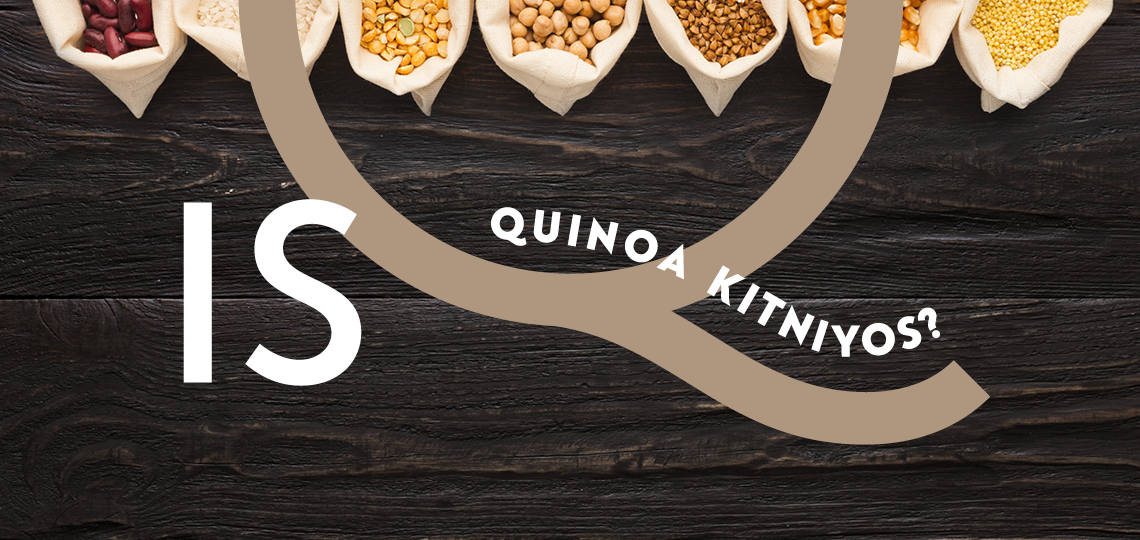People are always on the lookout to diversify their Pesach menu with healthy food choices. Quinoa, rich in protein, fiber, vitamins, and minerals, would seem to be a perfect solution. Even men, facing more than a week of eggs and potatoes, might consider giving quinoa one more chance.
Rishonim discuss the merits of an established minhag to refrain from eating kitniyos on Pesach. In practice, most Sephardic communities follow the psak of the Bais Yosef (O.C. 453:1) that kitniyos is permitted, whereas Ashkenazi communities follow the psak of the Rem”a that kitniyos is prohibited.
Kitniyos is loosely translated as legumes. However, the minhag includes several species that are not botanical legumes (e.g. rice, buckwheat, and mustard), hence, Poskim debate the kitniyos status of many types of foods; most recently, quinoa.
The Rishonim give two reasons for the prohibition of kitniyos. First, because of the similarities to the five chometz grains (wheat, barley, rye, spelt and oat) confusion can occur. Cooked dishes made from kitniyos appear similar to those from the five chometz grains. Furthermore, kitniyos are
often ground into a flour that can easily be confused with chometz flour. Finally, kitniyos are often grown in fields adjacent to those in which chometz is grown (and processed on the same equipment or stored together) and the kitniyos and chometz can easily mix together.
Food from the New World
Rav Moshe Feinstein zt”l (O.C. III: 63) was asked if peanuts are considered kitniyos since they are similar to peas (peanuts are actually legumes) and are commonly ground into flour. Rav Moshe responded that when the Rishonim gave the two above mentioned reasons, they did not intend to automatically add to the list newly discovered foods that have similar characteristics of kitniyos.
Rather, the minhag only applies to those species that were available in Europe at the time that the minhag was instituted. Case in point is the fact that potatoes are not considered kitniyos, although bread and cakes made from potatoes looks strikingly similar to those of the five chometz grains, and that is because potatoes were not yet present in Europe when the minhag was established.
As to the second reason, that chometz grains tend to mix with kitniyos, Rav Moshe points out several types of seeds, such as anise, elainder (coriander) and kimmel (caraway, cumin, or fennel) that the Rem”a considers as non-kitniyos, although these seeds are prone to be contaminated with wheat. Indeed, the Poskim (Mg”a and Ta”z) caution that they must be checked diligently before use. Apparently, such
contamination was not common at the time that the minhag was established, and therefore these seeds did not make it on to the kitniyos list. Rav
Moshe concludes that since peanuts were not present in Europe at the time of the Rishonim, they are not considered kitniyos.
The difficulty with Rav Moshe’s approach is the fact that maize (AKA corn) arrived in Europe at the same period potatoes did, and nevertheless all agree that corn is considered kitniyos. In a previous issue of Kosher Spirit (Spring 2009), the legendary Rabbi Zusha Yosef Blech Z”L explained why corn was the only new food that made it onto the kitniyos list: “While the common name for maize is corn, the origin of the word corn is quite different. In the Americas, it refers to maize, in Scotland to oats, and in Germany to wheat or rye. Yiddish speakers are similarly prone to this confusion, since they often use the term “korn” to refer to grain. It seems, however, that the popularity of corn – and its resulting assumption of this nickname – was sufficient for the minhag of kitniyos to extend to this new grain.”
In conclusion, after much consideration and lengthy discussions with leading Poskim, and since quinoa is not remotely similar to the five chometz grains and was not present in Europe at the time the custom was established, the OK considers quinoa as non-kitniyos. However, it is important to note that quinoa needs special kosher for Pesach certification, because quinoa seeds and flour are likely to be processed on the same equipment as the other five grains (especially with oats since both are gluten free). Therefore, only a reliable kosher for Passover supervision will guarantee that there are no actual chometz concerns.
Is Cannabis Kitniyos?
While discussing kitniyos oils, the Rishonim (Trumas Hadeshen, 205 and Mahari”l, 25) list “kanbus” oil as kitniyos. What is kanbus? The Radba”z (Kla’im 5:19) describes kanbus with the following: “It is intoxicating and people claim it makes them happy.” Accordingly, products made from the cannabis seed, like hemp oil or hemp milk are obviously kitniyos. On the other hand, products made from of the cannabis leaves, stalks or flowers (like CBD oil, hemp extract, terpenes, or marijuana – where legal, of course) would technically not be kitniyos. However, these products are commonly extracted and processed with alcohol and likely to have other Pesach sensitive ingredients blended in; therefore, as is the case with all processed food, it must be certified for Pesach by a reputable kashrus agency.







